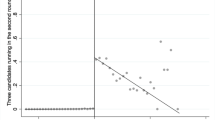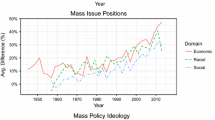Abstract
In this paper, we show that current statistical measures of legislator's shirking are implicitly based on the electoral concept of a unique majority rule equilibrium point in the policy space where elections are contested. We note that such equilibria do not exist generically and present statistical results showing that cross-sectional regressions where legislators' voting indices are predicted by district average demograhic and economic data are mis-specified. We also discuss a weaker equilibrium construct, the uncovered set, and present statistical evidence showing that differences in voting behavior between Senators from the same state are positively related to the heterogeneity of the electorate. We argue that current evidence alleged to show shirking by Senators is equally consistent with Senators who perfectly represent an idiosyncratic constituency that cannot be represented by district average data.
Similar content being viewed by others
References
Black, D. (1958).Theory of committees and elections. London: Cambridge University Press.
Coughlin, P. (1983). Davis-Hinich conditions and median outcomes in probabilistic voting models.Journal of Economic Theory 34: 1–12.
Coughlin, P. and Nitzan, S. (1981). Directional and local electoral equilibria with probabilistic voting,Journal of Economic Theory 24: 226–239.
Crain, W.M. and Goff, B. (1986). Televising legislatures: An economic analysis.Journal of Law and Economics 29: 405–421.
Davis, O., DeGroot, M. and Hinich, M. (1972). Social preference orderings and majority rule.Econometrica 40: 147–157.
Dougan, W. and Munger, M. (1989). The rationality of ideology.Journal of Law and Economics 32: 119–142.
Fenno, R. (1978).Home style: House members in their districts. Boston: Little, Brown.
Glazer, A. and Robbins, M. (1985). How elections matter: A study of U.S. senators.Public Choice 46: 163–172.
Grier, K. (1989). Campaign spending and senate elections, 1978–84.Public Choice 63: 201–219.
Grier, K. (1990). An empirical analysis of Senate elections: Campaign contributions and economic conditions. Mimeo.
Higgs, R. (1989). Do legislators' votes reflect constituency preference?Public Choice 63: 175–181.
Hinich, M., Ledyard, J. and Ordeshook, P. (1972). Nonvoting and the existence of equilibria under majority rule.Journal of Economic Theory 11: 144–153.
Kalt, J. and Zupan, M. (1984). Capture and ideology in the economic theory of politics.American Economic Review 74: 279–300.
Kalt, J. and Zupan, M. (1990). The apparent ideological behavior of legislators.Journal of Law and Economics 33: 103–131.
Krehbiel, K. (1993). Constituency characteristics and legislative preferences.Public Choice 76: 21–37.
Kau, J. and Rubin, P. (1978). Voting on minimum wages: A time series analysis.Journal of Political Economy 86: 221–237.
Kau, J. and Rubin, P. (1979). Self-interest, ideology, and logrolling in Congressional voting.Journal of Law and Economics 22: 365–384.
Kau, J. and Rubin, P. (1982).Congressmen, constituents, and contributors. Boston: Martinus Nijhoff.
Kramer, G. (1973). On a class of equilibrium conditions for majority rule.Econometrica 41: 285–297.
Lascher, E., Jr., Kelman, S. and Kane, T.J. (1993). Policy views, constituency pressure, and congressional action on flag burning.Public Choice 76: 79–102.
Lott, J.R., Jr. and Bronars, S.G. (1993). Time series evidence on shirking in the U.S. House of Representatives.Public Choice 76: 125–149.
Macdonald, S.E. and Rabinowitz, G. (1993). Ideology and candidate evaluation.Public Choice 76: 59–78.
McKelvey, R. (1986). Covering, dominance and institution free properties of social choice.American Journal of Political Science 30: 167–181.
McKelvey, R. and Ordeshook, P. (1982). Two-candidate elections without majority rule equilibria.Simulation and Games 13: 311–335.
Miller, N. (1980). A new solution set for tournaments and majority voting.American Journal of Political Science 24: 68–96.
Nelson, D. and Silberberg, E. (1987). Ideology and legislator shirking.Economic Inquiry 25: 15–25.
Peltzman, S. (1984). Constituent interest and congressional voting.Journal of Law and Economics 27: 181–210.
Plott, C. (1967). A notion of equilibrium under majority rule.American Economic Review 57: 787–806.
Wright, M.B. (1993). Shirking and political support in the U.S. Senate, 1964–1984.Public Choice 76: 103–123.
Author information
Authors and Affiliations
Additional information
We thank Tyler Cowen, Keith Krehbiel, John Lott, Michael Munger, Robert Tollison and Mark Zupan for useful comments and suggestions.
Rights and permissions
About this article
Cite this article
Goff, B.L., Grier, K.B. On the (mis)measurement of legislator ideology and shirking. Public Choice 76, 5–20 (1993). https://doi.org/10.1007/BF01049340
Accepted:
Issue Date:
DOI: https://doi.org/10.1007/BF01049340




